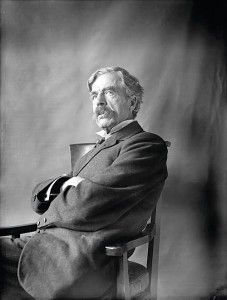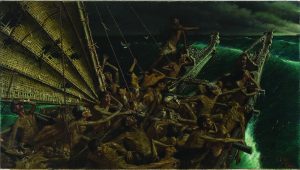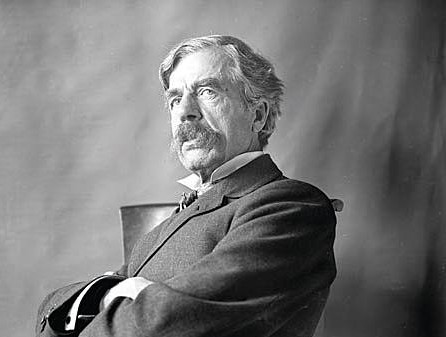by NZ CATHOLIC staff
Two Louis J. Steele works with connections to the Catholic Church are being sought by PhD researcher Jane Davidson-Ladd.

The missing works are a pastel of the signing of the Treaty of Waitangi once held at Sacred Heart College, Auckland, and Crucifixion, a painting gifted by the artist to St Benedict’s, Newton.
From the time of his arrival in New Zealand in 1886, Louis J. Steele was one of Auckland’s leading painters.
He was highly influential, with his paintings often named “picture of the exhibition” at the Auckland Society of Arts. He sought to professionalise art in Auckland and taught many artists, including Charles Goldie.
Although Steele is thought of as a New Zealand painter, he was born in Reigate, Surrey, in 1842. He trained at the Royal Academy, London, then the École des Beaux Arts, Paris, before returning to London.
Much is yet to be discovered about Steele’s career in England. He is known as an etcher for painters of note and appears to have been well connected to a number of royal academicians. His reasons for coming to New Zealand are unclear, but the death of his younger son six months before he left and the breakdown of his marriage appear to be contributing factors.

The Arrival of the Maoris in New Zealand, 1898, was painted by Louis Steele and Charles Frederick Goldie.
Steele was ambitious. Although most artists in Auckland were painting small landscapes, he created large-scale works, taking Maori and New Zealand history as his subjects. Most famously he collaborated with Goldie on The Arrival of the Maoris in New Zealand, 1898 — creating an epic fantasy of the discovery of Aotearoa.
In the early 1890s Steele worked on another subject of national significance — a painting of the signing of the
Treaty of Waitangi. It was to be funded by public subscription and intended to be hung at Parliament. Documentary
evidence suggests the planned painting was never finished, but a pastel preparatory drawing by Steele was auctioned
in 1917. It was bought by Harry Kavanagh, who gifted it to Sacred Heart College, Auckland. Measuring 5ft x 2ft (about 150 x 60cm) it was quite large for a drawing and presumably reasonably finished.
The pastel had pride of place in the school’s museum, where it was seen in 1932 by Governor-General Lord Bledisloe.
The college magazine reported that the drawing “at once arrested his attention. There has been much recent discussion as to the actual site of the signing — a discussion occasioned by their Excellencies’ generous gift to the nation of the old British Residency at Waitangi.
“Lord Bledisloe, in examining the picture, declared that it showed another angle to the discussion, and one that
might prove most helpful in arriving at a final decision.”
The Old Boys offered to have a copy made by Miss I. Copeland, and it was presented in 1933, with Bledisloe promising he would forward it to the Waitangi National Trust.
Regrettably the pastel drawing is no longer in the college’s possession and they have no further record of it. Nor
does the Waitangi National Trust have any knowledge of the copy. Despite many references to the drawing in newspapers
and magazines, no photographs of it have been found.
The work is historically important, not just as a work by Steele, but also for the subject it records. Although painted long after the signing of the Treaty, Steele did a great deal of historical research for the painting, including interviewing some who were present at the signing.
Steele’s Crucifixion, 1890, is a rare instance in his career of a religious subject. His reasons for attempting a crucifixion were most likely to showcase his ability as a figure painter and to encourage commissions from the Church.
The Crucifixion was first exhibited in 1890, being well received. The Auckland Star critic wrote that it “will elevate and ennoble everyone who looks upon it”. Described as 8ft high (about 2.4m), the figures of the Virgin Mary and Mary Magdalene were painted at the foot of the cross almost lifesize.
Steele later exhibited the painting in Melbourne, before gifting it to St Benedict’s in July 1893. Several undated
photographs show it hanging in the sanctuary above the Luck altar.
According to Fr Chris Loughnan, OP, a priest at St Benedict’s in the 1980s, the painting fell out of favour during
the time Bishop James Liston, as coadjutor to Bishop Cleary, was parish priest in the 1920s.
Reputedly Liston had it removed, as he took offence at Mary shown collapsed on her knees. The painting was dispatched to the school, where it stayed until the school’s closure in the early 1980s, whereupon it returned to the church hanging in a stairwell leading to the crypt.
Not long after the painting was stolen, and it has never been found.
Although Steele is well represented in public collections, those two lost works are highly significant within his output.
Finding them would help in reassessing his contribution to New Zealand art.
Steele was an important figure and the extent of his influence is yet to be fully acknowledged.
If you know of any artworks by Louis John Steele, or materials relating to him, such as correspondence, please contact Jane Davidson-Ladd. Phone: 09 623 7001 or 021 385833. Email: jdav003@aucklanduni

Reader Interactions